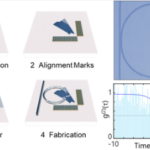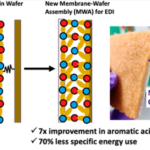科学者たちは、最近発見された超伝導体群の微視的構造を初めて説明し、将来の超伝導技術の進歩に道を開く小さな一歩を踏み出しました。 Scientists describe the microscopic structure of a recently discovered group of superconductors for the first time, a small step toward paving the way for future advances in superconducting technology.
2023-02-10 ブラウン大学
◆ブラウン大学の研究室では、国際的な科学者チームと協力して、最近発見されたカゴメ超伝導金属について、この謎の解明に一歩近づいた。この新しい研究では、核磁気共鳴イメージングと量子モデリング理論を組み合わせた革新的な新手法を用いて、103度ケルビン(華氏0度から約275度に相当)の超伝導体の微視的構造を説明した。
◆研究者らは、この奇妙な物質状態の特性について、『Physical Review Research』誌に初めてと思われる記載を行った。
◆この新しい研究は、ルビジウム・バナジウムとアンチモンの金属からなる超伝導体RbV3Sb5に焦点を当てています。この物質は、その特異な原子構造が、星型の三角形が相互に接続された籠目模様に似ていることから、その名が付けられた。カゴメは、トポロジカル量子物理学と物性物理学という物理学の最も基本的な2つの分野の架け橋となり、量子現象への洞察をもたらすことから、研究者を魅了している。
◆この物質は、温度を下げるとさまざまな相転移を繰り返し、エキゾチックな性質をもつ異なる状態の物質を形成することが、別のグループによるこれまでの研究で明らかにされている。この物質を103ケルビンにすると、格子の構造が変化し、電荷密度が上下にジャンプする「電荷密度波」と呼ばれる現象を示すようになる。この電荷密度波を理解することは、超伝導体のような量子物質における電子の振る舞いを記述する理論の開発に重要である。
◆研究チームは、NMR測定と、原子の電気的構造と位置をシミュレートするために用いられる密度汎関数理論と呼ばれるモデリング理論を組み合わせた新しい戦略を用いて、格子が変化する新しい構造とその電荷密度波について説明することができた。
◆その結果、ダビデの星をモチーフにした2x2x1パターンから、2x2x2パターンに構造が変化することがわかった。これは、カゴメの格子が極端に温度が下がると反転してしまうために起こる現象である。研究チームは、カゴメ格子が反転する際に、六角形と三角形で構成された新しい格子が出現することを明らかにした。また、RbV3Sb5構造の1つの面を回転させ、別の角度から「注視」すると、このパターンがどのようにつながるかも明らかにした。
<関連情報>
- https://www.brown.edu/news/2023-02-10/kagome-metal-discoveries
- https://journals.aps.org/prresearch/abstract/10.1103/PhysRevResearch.5.L012017
カゴメ超伝導体RbV3Sb5における電荷密度波の微視的性質 Microscopic nature of the charge-density wave in the kagome superconductor RbV3Sb5
Jonathan Frassineti, Pietro Bonfà, Giuseppe Allodi, Erick Garcia, Rong Cong, Brenden R. Ortiz, Stephen D. Wilson, Roberto De Renzi, Vesna F. Mitrović, and Samuele Sanna
Physical Review Research Published 10 February 2023
DOI:https://doi.org/10.1103/PhysRevResearch.5.L012017
ABSTRACT
The recently discovered vanadium-based Kagome metals AV3Sb5 (A = K, Rb, Cs) undergo a unique phase transition into charge-density wave (CDW) order which precedes both unconventional superconductivity and time-reversal symmetry breaking. Therefore the essential first step in building a full understanding of the role of CDW in establishing these unconventional phases is to unveil the symmetries and the microscopic nature of the charge-ordered phase. Here, we determine the exact structure of the 2×2×2 superlattice that develops below the charge-density wave ordering temperature (TCDW) in RbV3Sb5. We present a comprehensive set of 51V, 87Rb, and 121Sb nuclear magnetic resonance (NMR) measurements and density functional theory simulations of NMR observables to provide a unique site-selective view into the local nature of the charge-ordered phase. The combination of these experimental results with simulations provides compelling evidence that the CDW structure prevailing below 103 K in RbV3Sb5 is the so-called inverse Star of David pattern, π-shifted along the c axis. These findings put severe constraints on the topology of these Kagome compounds and thus provide essential guidance for the development of an appropriate theoretical framework for predicting properties of exotic electronic orders arising within the CDW phase.



